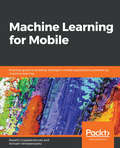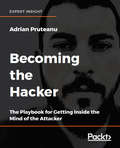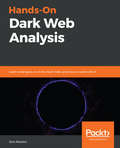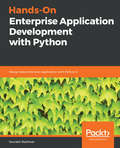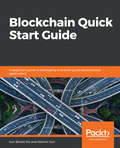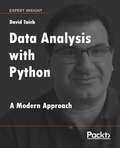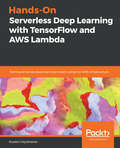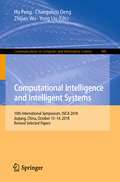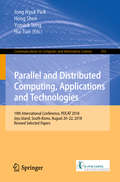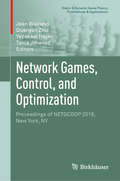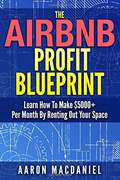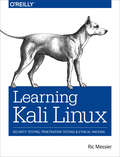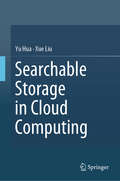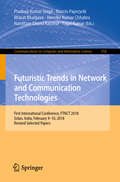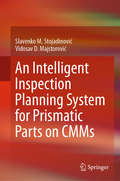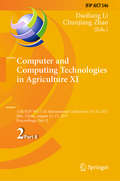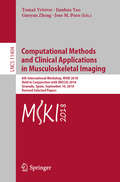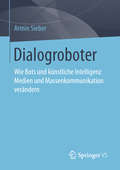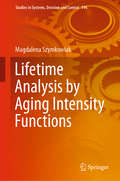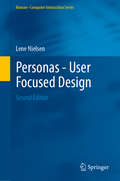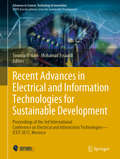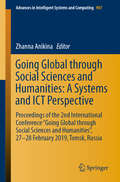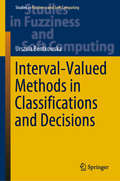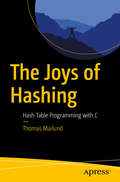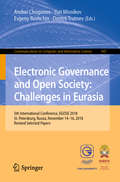- Table View
- List View
Machine Learning for Mobile: Practical guide to building intelligent mobile applications powered by machine learning
by Revathi Gopalakrishnan Avinash VenkateswarluLeverage the power of machine learning on mobiles and build intelligent mobile applications with ease Key Features Build smart mobile applications for Android and iOS devices Use popular machine learning toolkits such as Core ML and TensorFlow Lite Explore cloud services for machine learning that can be used in mobile apps Book Description Machine learning presents an entirely unique opportunity in software development. It allows smartphones to produce an enormous amount of useful data that can be mined, analyzed, and used to make predictions. This book will help you master machine learning for mobile devices with easy-to-follow, practical examples. You will begin with an introduction to machine learning on mobiles and grasp the fundamentals so you become well-acquainted with the subject. You will master supervised and unsupervised learning algorithms, and then learn how to build a machine learning model using mobile-based libraries such as Core ML, TensorFlow Lite, ML Kit, and Fritz on Android and iOS platforms. In doing so, you will also tackle some common and not-so-common machine learning problems with regard to Computer Vision and other real-world domains. By the end of this book, you will have explored machine learning in depth and implemented on-device machine learning with ease, thereby gaining a thorough understanding of how to run, create, and build real-time machine-learning applications on your mobile devices. What you will learn Build intelligent machine learning models that run on Android and iOS Use machine learning toolkits such as Core ML, TensorFlow Lite, and more Learn how to use Google Mobile Vision in your mobile apps Build a spam message detection system using Linear SVM Using Core ML to implement a regression model for iOS devices Build image classification systems using TensorFlow Lite and Core ML Who this book is for If you are a mobile app developer or a machine learning enthusiast keen to use machine learning to build smart mobile applications, this book is for you. Some experience with mobile application development is all you need to get started with this book. Prior experience with machine learning will be an added bonus
Becoming the Hacker: The Playbook for Getting Inside the Mind of the Attacker
by Adrian PruteanuWeb penetration testing by becoming an ethical hacker. Protect the web by learning the tools, and the tricks of the web application attacker. Key Features Builds on books and courses on penetration testing for beginners Covers both attack and defense perspectives Examines which tool to deploy to suit different applications and situations Book Description Becoming the Hacker will teach you how to approach web penetration testing with an attacker's mindset. While testing web applications for performance is common, the ever-changing threat landscape makes security testing much more difficult for the defender. There are many web application tools that claim to provide a complete survey and defense against potential threats, but they must be analyzed in line with the security needs of each web application or service. We must understand how an attacker approaches a web application and the implications of breaching its defenses. Through the first part of the book, Adrian Pruteanu walks you through commonly encountered vulnerabilities and how to take advantage of them to achieve your goal. The latter part of the book shifts gears and puts the newly learned techniques into practice, going over scenarios where the target may be a popular content management system or a containerized application and its network. Becoming the Hacker is a clear guide to web application security from an attacker's point of view, from which both sides can benefit. What you will learn Study the mindset of an attacker Adopt defensive strategies Classify and plan for standard web application security threats Prepare to combat standard system security problems Defend WordPress and mobile applications Use security tools and plan for defense against remote execution Who this book is for The reader should have basic security experience, for example, through running a network or encountering security issues during application development. Formal education in security is useful, but not required. This title is suitable for people with at least two years of experience in development, network management, or DevOps, or with an established interest in security.
Hands-On Dark Web Analysis: Learn what goes on in the Dark Web, and how to work with it
by Sion RetzkinUnderstanding the concept Dark Web and Dark Net to utilize it for effective cybersecurity Key Features Understand the concept of Dark Net and Deep Web Use Tor to extract data and maintain anonymity Develop a security framework using Deep web evidences Book Description The overall world wide web is divided into three main areas - the Surface Web, the Deep Web, and the Dark Web. The Deep Web and Dark Web are the two areas which are not accessible through standard search engines or browsers. It becomes extremely important for security professionals to have control over these areas to analyze the security of your organization. This book will initially introduce you to the concept of the Deep Web and the Dark Web and their significance in the security sector. Then we will deep dive into installing operating systems and Tor Browser for privacy, security and anonymity while accessing them. During the course of the book, we will also share some best practices which will be useful in using the tools for best effect. By the end of this book, you will have hands-on experience working with the Deep Web and the Dark Web for security analysis What you will learn Access the Deep Web and the Dark Web Learn to search and find information in the Dark Web Protect yourself while browsing the Dark Web Understand what the Deep Web and Dark Web are Learn what information you can gather, and how Who this book is for This book is targeted towards security professionals, security analyst, or any stakeholder interested in learning the concept of deep web and dark net. No prior knowledge on Deep Web and Dark Net is required
Hands-On Enterprise Application Development with Python: Design data-intensive Application with Python 3
by Saurabh BadhwarArchitect scalable, reliable, and maintainable applications for enterprises with Python Key Features Explore various Python design patterns used for enterprise software development Apply best practices for testing and performance optimization to build stable applications Learn about different attacking strategies used on enterprise applications and how to avoid them Book Description Dynamically typed languages like Python are continuously improving. With the addition of exciting new features and a wide selection of modern libraries and frameworks, Python has emerged as an ideal language for developing enterprise applications. Hands-On Enterprise Application Development with Python will show you how to build effective applications that are stable, secure, and easily scalable. The book is a detailed guide to building an end-to-end enterprise-grade application in Python. You will learn how to effectively implement Python features and design patterns that will positively impact your application lifecycle. The book also covers advanced concurrency techniques that will help you build a RESTful application with an optimized frontend. Given that security and stability are the foundation for an enterprise application, you'll be trained on effective testing, performance analysis, and security practices, and understand how to embed them in your codebase during the initial phase. You'll also be guided in how to move on from a monolithic architecture to one that is service oriented, leveraging microservices and serverless deployment techniques. By the end of the book, you will have become proficient at building efficient enterprise applications in Python. What you will learn Understand the purpose of design patterns and their impact on application lifecycle Build applications that can handle large amounts of data-intensive operations Uncover advanced concurrency techniques and discover how to handle a large number of requests in production Optimize frontends to improve the client-side experience of your application Effective testing and performance profiling techniques to detect issues in applications early in the development cycle Build applications with a focus on security Implement large applications as microservices to improve scalability Who this book is for If you're a developer who wants to build enterprise-grade applications, this book is for you. Basic to intermediate-level of programming experience with Python and database systems is required to understand the concepts covered in this book.
Blockchain Quick Start Guide: A beginner's guide to developing enterprise-grade decentralized applications
by Xun Brian Wu Weimin SunLearn quick and effective techniques to get up and running with building blockchain including Ethereum and Hyperledger Fabric. Key Features Understand the key concepts of decentralized applications and consensus algorithms Learn key concepts of Ethereum and Solidity programming Practical guide to get started with build efficient Blockchain applications with Ethereum and Hyperledger Book Description Blockchain is a technology that powers the development of decentralized applications.This technology allows the construction of a network with no single control that enables participants to make contributions to and receive benefits from the network directly. This book will give you a thorough overview of blockchain and explain how a blockchain works.You will begin by going through various blockchain consensus mechanisms and cryptographic hash functions. You will then learn the fundamentals of programming in Solidity – the defacto language for developing decentralize, applications in Ethereum. After that, you will set up an Ethereum development environment and develop, package, build, and test campaign-decentralized applications.The book also shows you how to set up Hyperledger composer tools, analyze business scenarios, design business models, and write a chain code. Finally, you will get a glimpse of how blockchain is actually used in different real-world domains. By the end of this guide, you will be comfortable working with basic blockchain frameworks, and develop secure, decentralized applications in a hassle-free manner. What you will learn Understand how blockchain hashing works Write and test a smart contract using Solidity Develop and test a decentralized application Build and test your application using Hyperledger Fabric Implement business network using Hyperledger Composer Test and interact with business network applications Who this book is for The book is for developers, analysts, or anyone looking to learn about Blockchain in a quick and easy manner.
Data Analysis with Python: A Modern Approach
by David TaiebLearn a modern approach to data analysis using Python to harness the power of programming and AI across your data. Detailed case studies bring this modern approach to life across visual data, social media, graph algorithms, and time series analysis. Key Features Bridge your data analysis with the power of programming, complex algorithms, and AI Use Python and its extensive libraries to power your way to new levels of data insight Work with AI algorithms, TensorFlow, graph algorithms, NLP, and financial time series Explore this modern approach across with key industry case studies and hands-on projects Book Description Data Analysis with Python offers a modern approach to data analysis so that you can work with the latest and most powerful Python tools, AI techniques, and open source libraries. Industry expert David Taieb shows you how to bridge data science with the power of programming and algorithms in Python. You'll be working with complex algorithms, and cutting-edge AI in your data analysis. Learn how to analyze data with hands-on examples using Python-based tools and Jupyter Notebook. You'll find the right balance of theory and practice, with extensive code files that you can integrate right into your own data projects. Explore the power of this approach to data analysis by then working with it across key industry case studies. Four fascinating and full projects connect you to the most critical data analysis challenges you're likely to meet in today. The first of these is an image recognition application with TensorFlow – embracing the importance today of AI in your data analysis. The second industry project analyses social media trends, exploring big data issues and AI approaches to natural language processing. The third case study is a financial portfolio analysis application that engages you with time series analysis - pivotal to many data science applications today. The fourth industry use case dives you into graph algorithms and the power of programming in modern data science. You'll wrap up with a thoughtful look at the future of data science and how it will harness the power of algorithms and artificial intelligence. What you will learn A new toolset that has been carefully crafted to meet for your data analysis challenges Full and detailed case studies of the toolset across several of today's key industry contexts Become super productive with a new toolset across Python and Jupyter Notebook Look into the future of data science and which directions to develop your skills next Who this book is for This book is for developers wanting to bridge the gap between them and data scientists. Introducing PixieDust from its creator, the book is a great desk companion for the accomplished Data Scientist. Some fluency in data interpretation and visualization is assumed. It will be helpful to have some knowledge of Python, using Python libraries, and some proficiency in web development.
Hands-On Serverless Deep Learning with TensorFlow and AWS Lambda: Training serverless deep learning models using the AWS infrastructure
by Rustem FeyzkhanovUse the serverless computing approach to save time and money Key Features Save your time by deploying deep learning models with ease using the AWS serverless infrastructure Get a solid grip on AWS services and use them with TensorFlow for efficient deep learning Includes tips, tricks and best practices on serverless deep learning that you can use in a production environment Book Description One of the main problems with deep learning models is finding the right way to deploy them within the company's IT infrastructure. Serverless architecture changes the rules of the game—instead of thinking about cluster management, scalability, and query processing, it allows us to focus specifically on training the model. This book prepares you to use your own custom-trained models with AWS Lambda to achieve a simplified serverless computing approach without spending much time and money. You will use AWS Services to deploy TensorFlow models without spending hours training and deploying them. You'll learn to deploy with serverless infrastructures, create APIs, process pipelines, and more with the tips included in this book. By the end of the book, you will have implemented your own project that demonstrates how to use AWS Lambda effectively so as to serve your TensorFlow models in the best possible way. What you will learn Gain practical experience by working hands-on with serverless infrastructures (AWS Lambda) Export and deploy deep learning models using Tensorflow Build a solid base in AWS and its various functions Create a deep learning API using AWS Lambda Look at the AWS API gateway Create deep learning processing pipelines using AWS functions Create deep learning production pipelines using AWS Lambda and AWS Step Function Who this book is for This book will benefit data scientists who want to learn how to deploy models easily and beginners who want to learn about deploying into the cloud. No prior knowledge of TensorFlow or AWS is required.
Computational Intelligence and Intelligent Systems: 9th International Symposium, Isica 2017, Guangzhou, China, November 18-20, 2017. Revised Selected Papers, Part I (Communications in Computer and Information Science #873)
by Hu Peng Changshou Deng Zhijian Wu Yong LiuThis two-volume set (CCIS 873 and CCIS 874) constitutes the thoroughly refereed proceedings of the 9th International Symposium, ISICA 2017, held in Guangzhou, China, in November 2017. The 101 full papers presented in both volumes were carefully reviewed and selected from 181 submissions. This second volume is organized in topical sections on swarm intelligence: cooperative Search, swarm optimization; complex systems modeling: system dynamic, multimedia simulation; intelligent information systems: information retrieval, e-commerce platforms; artificial intelligence and robotics: query optimization, intelligent engineering; virtualization: motion-based tracking, image recognition.
Parallel and Distributed Computing, Applications and Technologies: 19th International Conference, Pdcat 2018, Jeju Island, South Korea, August 20-22, 2018, Revised Selected Papers (Communications in Computer and Information Science #931)
by Jong Hyuk Park Hong Shen Yunsick Sung Hui TianThis book constitutes the refereed proceedings of the 19th International Conference on CParallel and Distributed Computing, Applications and Technologies, PDCAT 2018, held in Jeju Island, South Korea, in August 2018. The 35 revised full papers presented along with the 14 short papers and were carefully reviewed and selected from 150 submissions. The papers of this volume are organized in topical sections on wired and wireless communication systems, high dimensional data representation and processing, networks and information security, computing techniques for efficient networks design, electronic circuits for communication systems.
Network Games, Control, and Optimization: Proceedings Of Netgcoop 2016, Avignon, France (Static & Dynamic Game Theory: Foundations & Applications)
by Jean Walrand Quanyan Zhu Yezekael Hayel Tania JimenezThis contributed volume offers a collection of papers presented at the 2016 Network Games, Control, and Optimization conference (NETGCOOP), held at the University of Avignon in France, November 23-25, 2016. These papers highlight the increasing importance of network control and optimization in many networking application domains, such as mobile and fixed access networks, computer networks, social networks, transportation networks, and, more recently, electricity grids and biological networks. Covering a wide variety of both theoretical and applied topics in the areas listed above, the authors explore several conceptual and algorithmic tools that are needed for efficient and robust control operation, performance optimization, and better understanding the relationships between entities that may be acting cooperatively or selfishly in uncertain and possibly adversarial environments. As such, this volume will be of interest to applied mathematicians, computer scientists, engineers, and researchers in other related fields.
The Airbnb Profit Blueprint: Learn How To Make $5000+ Per Month By Renting Out Your Space
by Aaron MacDanielHave you ever heard about AirBnB but aren't sure how to get started? Or are you an AirBnB host already looking for ways to maximize your bookings, increase your AirBnB ranking, and reduce the amount of time you spend working on your listing? Then you have come to the right place!AirBnB is a very flexible platform, and it can work for a variety of situations. Do you have a spare room in your house or apartment? It could even be your living room, a trailer, a boat, or an igloo (there was a very popular igloo in Boston last winter), there are very few limits as to what you can rent out on Airbnb. Or maybe you want to go to the next level and rent out your entire home or apartment on AirBnB while you travel or live elsewhere? Then we have a blueprint to get you started and show you exactly what to do.This book will help the complete novice and experienced AirBnB host alike, as there are tips for students at every level. I walk you through everything you need to know about renting out your spare room or your entire apartment on AirBnB.
Learning Kali Linux: Security Testing, Penetration Testing, and Ethical Hacking
by Ric MessierWith more than 600 security tools in its arsenal, the Kali Linux distribution can be overwhelming. Experienced and aspiring security professionals alike may find it challenging to select the most appropriate tool for conducting a given test. This practical book covers Kali’s expansive security capabilities and helps you identify the tools you need to conduct a wide range of security tests and penetration tests. You’ll also explore the vulnerabilities that make those tests necessary.Author Ric Messier takes you through the foundations of Kali Linux and explains methods for conducting tests on networks, web applications, wireless security, password vulnerability, and more. You’ll discover different techniques for extending Kali tools and creating your own toolset.Learn tools for stress testing network stacks and applicationsPerform network reconnaissance to determine what’s available to attackersExecute penetration tests using automated exploit tools such as MetasploitUse cracking tools to see if passwords meet complexity requirementsTest wireless capabilities by injecting frames and cracking passwordsAssess web application vulnerabilities with automated or proxy-based toolsCreate advanced attack techniques by extending Kali tools or developing your ownUse Kali Linux to generate reports once testing is complete
Searchable Storage in Cloud Computing
by Yu Hua Xue LiuThis book presents the state-of-the-art work in terms of searchable storage in cloud computing. It introduces and presents new schemes for exploring and exploiting the searchable storage via cost-efficient semantic hashing computation. Specifically, the contents in this book include basic hashing structures (Bloom filters, locality sensitive hashing, cuckoo hashing), semantic storage systems, and searchable namespace, which support multiple applications, such as cloud backups, exact and approximate queries and image analytics. Readers would be interested in the searchable techniques due to the ease of use and simplicity. More importantly, all these mentioned structures and techniques have been really implemented to support real-world applications, some of which offer open-source codes for public use. Readers will obtain solid backgrounds, new insights and implementation experiences with basic knowledge in data structure and computer systems.
Futuristic Trends in Network and Communication Technologies: First International Conference, FTNCT 2018, Solan, India, February 9–10, 2018, Revised Selected Papers (Communications in Computer and Information Science #958)
by Pradeep Kumar Singh Marcin Paprzycki Bharat Bhargava Jitender Kumar Chhabra Narottam Chand Kaushal Yugal KumarThis book constitutes the refereed proceedings of the First International Conference on Futuristic Trends in Network and Communication Technologies, FTNCT 2018, held in Solan, India, in February 2018. The 37 revised full papers presented were carefully reviewed and selected from 239 submissions. The prime aim of the conference is to invite researchers from different domains of network and communication technologies to a single platform to showcase their research ideas. The selected papers are organized in topical sections on communication technologies, Internet of Things (IoT), network technologies, and wireless networks.
An Intelligent Inspection Planning System for Prismatic Parts on CMMs
by Slavenko M. Stojadinović Vidosav D. MajstorovićThis book examines an intelligent system for the inspection planning of prismatic parts on coordinate measuring machines (CMMs). The content focuses on four main elements: the engineering ontology, the model of inspection planning for prismatic parts on CMMs, the optimisation model of the measuring path based on an ant-colony approach, and the model of probe configuration and setup planning based on a genetic algorithm. The model of inspection planning for CMMs developed here addresses inspection feature construction, the sampling strategy, probe accessibility analysis, automated collision-free operation, and probe path planning. The proposed model offers a novel approach to intelligent inspection, while also minimizing human involvement (and thus the risk of human error) through intelligent planning of the probe configuration and part setup. The advantages of this approach include: reduced preparation times due to the automatic generation of a measuring protocol; potential optimisation of the measuring probe path, i.e., less time needed for the actual measurement; and increased planning process autonomy through minimal human involvement in the setup analysis and probe configuration.
Computer and Computing Technologies in Agriculture XI: 11th IFIP WG 5.14 International Conference, CCTA 2017, Jilin, China, August 12-15, 2017, Proceedings, Part II (IFIP Advances in Information and Communication Technology #546)
by Daoliang Li Chunjiang ZhaoThe two volumes IFIP AICT 545 and 546 constitute the refereed post-conference proceedings of the 11th IFIP WG 5.14 International Conference on Computer and Computing Technologies in Agriculture, CCTA 2017, held in Jilin, China, in August 2017.The 100 revised papers included in the two volumes were carefully reviewed and selected from 282 submissions. They cover a wide range of interesting theories and applications of information technology in agriculture. The papers focus on four topics: Internet of Things and big data in agriculture, precision agriculture and agricultural robots, agricultural information services, and animal and plant phenotyping for agriculture.
Computational Methods and Clinical Applications in Musculoskeletal Imaging: 6th International Workshop, MSKI 2018, Held in Conjunction with MICCAI 2018, Granada, Spain, September 16, 2018, Revised Selected Papers (Lecture Notes in Computer Science #11404)
by Tomaž Vrtovec Jianhua Yao Guoyan Zheng Jose M. PozoThis book constitutes the refereed proceedings of the 6th International Workshop on Computational Methods and Clinical Applications for Musculoskeletal Imaging, MSKI 2018, held in conjunction with MICCAI 2018, in Granada, Spain, in September 2018. The 13 workshop papers were carefully reviewed and selected for inclusion in this volume. Topics of interest include all major aspects of musculoskeletal imaging, for example: clinical applications of musculoskeletal computational imaging; computer-aided detection and diagnosis of conditions of the bones, muscles and joints; image-guided musculoskeletal surgery and interventions; image-based assessment and monitoring of surgical and pharmacological treatment; segmentation, registration, detection, localization and visualization of the musculoskeletal anatomy; statistical and geometrical modeling of the musculoskeletal shape and appearance; image-based microstructural characterization of musculoskeletal tissue; novel techniques for musculoskeletal imaging.
Dialogroboter: Wie Bots und künstliche Intelligenz Medien und Massenkommunikation verändern
by Armin SieberTechnologien wie künstliche Intelligenz und Natural Language Programming werden zu Auslösern der sogenannten „Dialogwende“. Darunter versteht dieses Buch die massenweise Verbreitung von autonom sprechenden Sprachdialogsystemen und automatischen Sprachassistenten. Der Autor geht der Frage nach, welche Technologien bereits zur Verfügung stehen oder bald zur Serienreife kommen. Er analysiert konkrete Verwendungen und Einsatzfelder von Bots und stellt sich die Frage, was bei der Planung und Konzeption bedacht werden muss, welche Veränderungen in Medien und Unternehmenskommunikation zu erwarten sind. Das Buch beleuchtet darüber hinaus auch die psychosozialen Folgen, die auf unsere Gesellschaft zukommen, wenn Sprachdialogsysteme in großer Zahl zum Einsatz kommen.
Lifetime Analysis by Aging Intensity Functions (Studies in Systems, Decision and Control #196)
by Magdalena SzymkowiakThis book addresses a range of aging intensity functions, which make it possible to measure and compare aging trends for lifetime random variables. Moreover, they can be used for the characterization of lifetime distributions, also with bounded support. Stochastic orders based on the aging intensities, and their connections with some other orders, are also discussed. To demonstrate the applicability of aging intensity in reliability practice, the book analyzes both real and generated data. The estimated, properly chosen, aging intensity function is mainly recommended to identify data’s lifetime distribution, and secondly, to estimate some of the parameters of the identified distribution. Both reliability researchers and practitioners will find the book a valuable guide and source of inspiration.
Personas - User Focused Design: User Focused Design (Human–Computer Interaction Series #15)
by Lene NielsenPeople relate to other people, not to simplified types or segments. This is the concept that underpins this book. Personas, a user centered design methodology, covers topics from interaction design within IT, through to issues surrounding product design, communication, and marketing. Project developers need to understand how users approach their products from the product’s infancy, and regardless of what the product might be. Developers should be able to describe the user of the product via vivid depictions, as if they – with their different attitudes, desires and habits – were already using the product. In doing so they can more clearly formulate how to turn the product's potential into reality. Based on 20 years’ experience in solving problems for businesses and 15 years of research, currently at the IT University of Copenhagen, Lene Nielsen is Denmark’s leading expert in the persona method. She has a PhD in personas and scenarios, and through her research and practical experiences has developed her own approach to the method – 10 Steps to Personas. This second edition of Personas – User Focused Design presents a step-by-step methodology of personas which will be of interest to developers of IT, communications solutions and innovative products. This book also includes three new chapters and considerable expansion on the material in the first edition.
Recent Advances in Electrical and Information Technologies for Sustainable Development: Proceedings of the 3rd International Conference on Electrical and Information Technologies — ICEIT 2017, Morocco (Advances in Science, Technology & Innovation)
by Soumia El Hani Mohamad EssaaidiThe book includes the best extended papers which were selected from the 3rd International Conference of Electrical and Information Technologies (ICEIT 2017, Morocco). The book spans two inter-related research domains which shaped modern societies, solved many of their development problems, and contributed to their unprecedented economic growth and social welfare. Selected papers are based on original and high quality research. They were peer reviewed by experts in the field. They are grouped into five parts. Part I deals with Power System and Electronics topics that include Power Electronics & Energy Conversion, Actuators & Micro/Nanotechnology, etc. Part II relates to Control Systems and their applications. Part III concerns the topic of Information Technology that basically includes Smart Grid, Information Security, Cloud Computing Distributed, Big Data, etc. Part IV discusses Telecommunications and Vehicular Technologies topics that include, Green Networking and Communications, Wireless Ad-hoc and Sensor Networks, etc. Part V covers Green Applications and Interdisciplinary topics, that include intelligent and Green Technologies for Transportation Systems, Smart Cities, etc. This book offers a good opportunity for young researchers, novice scholars and whole academic sphere to explore new trends in Electrical and information Technologies.
Going Global through Social Sciences and Humanities: Proceedings of the 2nd International Conference “Going Global through Social Sciences and Humanities”, 27-28 February 2019, Tomsk, Russia (Advances in Intelligent Systems and Computing #907)
by Zhanna AnikinaThis book presents contributions submitted to the 2nd international conference Going Global through Social Sciences and Humanities (GGSSH 2019) held in Tomsk, Russia on 27–28 February 2019. The conference focused on such issues as interdisciplinary pedagogy, language teaching and learning, cultural studies and linguistics, particularly highlighting global academic integration and professional development for research. As such, the event provided a platform for discussions and sharing publication activities, to help Russian academics to take first steps toward global research.Showcasing the ongoing Russian research in focus areas, this book is of interest to a diverse academic audience working in social sciences and humanities, particularly those from the post-Soviet countries.
Interval-Valued Methods in Classifications and Decisions (Studies in Fuzziness and Soft Computing #378)
by Urszula BentkowskaThis book describes novel algorithms based on interval-valued fuzzy methods that are expected to improve classification and decision-making processes under incomplete or imprecise information. At first, it introduces interval-valued fuzzy sets. It then discusses new methods for aggregation on interval-valued settings, and the most common properties of interval-valued aggregation operators. It then presents applications such as decision making using interval-valued aggregation, and classification in case of missing values. Interesting applications of the developed algorithms to DNA microarray analysis and in medical decision support systems are shown. The book is intended not only as a timely report for the community working on fuzzy sets and their extensions but also for researchers and practitioners dealing with the problems of uncertain or imperfect information.
The Joys of Hashing: Hash Table Programming with C
by Thomas MailundBuild working implementations of hash tables, written in the C programming language. This book starts with simple first attempts devoid of collision resolution strategies, and moves through improvements and extensions illustrating different design ideas and approaches, followed by experiments to validate the choices. Hash tables, when implemented and used appropriately, are exceptionally efficient data structures for representing sets and lookup tables, providing low overhead, constant time, insertion, deletion, and lookup operations. The Joys of Hashing walks you through the implementation of efficient hash tables and the pros and cons of different design choices when building tables. The source code used in the book is available on GitHub for your re-use and experiments.What You Will LearnMaster the basic ideas behind hash tablesCarry out collision resolution, including strategies for handling collisions and their consequences for performanceResize or grow and shrink tables as neededStore values by handling when values must be stored with keys to make general sets and mapsWho This Book Is ForThose with at least some prior programming experience, especially in C programming.
Electronic Governance and Open Society: 5th International Conference, EGOSE 2018, St. Petersburg, Russia, November 14-16, 2018, Revised Selected Papers (Communications in Computer and Information Science #947)
by Andrei Chugunov Yuri Misnikov Evgeny Roshchin Dmitrii TrutnevThis book constitutes the refereed proceedings of the 5th Conference on AElectronic Governance and Open Society: Challenges in Eurasia, EGOSE 2018, held in St. Petersburg, Russia, in November 2018. The 36 revised full papers were carefully reviewed and selected from 98 submissions. The papers are organized in topical sections on smart city infrastructure, policy; digital privacy, rights,security;data science, machine learning, algorithms, computational linguistics; digital public administration, economy, policy; digital services, values, inclusion; digital democracy, participation, security, communities, social media, activism; social media discourse analysis; digital data, policy modeling; digital government, administration, communication.
